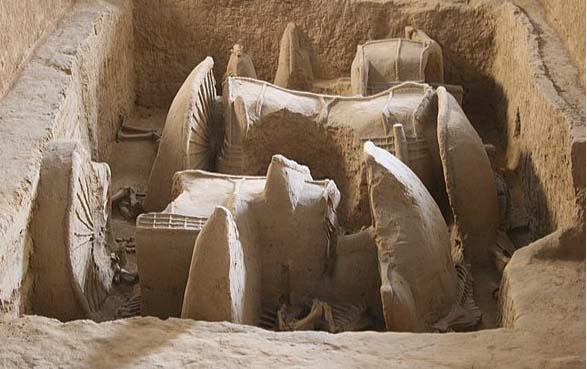Ancient China in Context
Spring and Autumn:
A Chinese Military Revolution
E Bruce Brooks and A Taeko Brooks
The Spring and Autumn Chronicle of the state of Lu, the Chun/Chyou (CC) gives an eyewitness account of the 08th to 06th centuries: an otherwise almost undocumented period in Chinese history. It gives an inside view of a state undergoing change: in its structure (from a palace state to a bureaucratic state), and from one form of warfare (the chariots pictured here) to another (the slower infantry). This change made possible the more effective warfare of the Warring States period, leading eventually to the unified Empire, into which all the states had been absorbed.
The chronicle gives not only a detailed picture of goings-on in modest-sized Lu, but also of the court intrigues of the great states, Chi and Jin. We know, in surprising detail, what problems they faced, and what they were doing about them. The Spring and Autumn period is of interest, not only for students of social and political structures, but also because the last third of it is the background of the life and work of Confucius.
The book begins with a general introduction, and continues with profiles of each of the twelve rulers of Lu, and of individuals who made an important contribution during each of their reigns.
The CC is said to be "dry as dust." Those who want their ancient China served up with plenty of sex and violence will find it done that way in the Dzwo Jwan. But before turning to it, consider the concuding essays in this book, which show that the Dzwo Jwan has its own theory of history, and that it rewrites the real history along those lines, deceiving not only its own audience, but many modern people as well: the comic-book public of ancent and modern times.
Cover
Halftitle
Title Page
Dedication
Preface
Contents
Orientation, 11
1. The Ruler, 13
2. The Astrologer, 15
3. Defining Boundaries, 17
4. Victory and Defeat, 19
5. The Threat From Chu, 21
The First Phase (9722-0660), 23
6. Yin-gung (0722-0712), 25
7. Hwei, 29
8, Hwan-gung (0711-0694), 31
9, Land Exchange with Jvng, 34
10. Indiscetion in Sung, 36
11. Marriage with Chi, 00,
12. Jwang-gung (0693-0662),
13. The End of Ji, 00
14. A Chi Succession Dispute, 00
15. Wvn Jyang of Chi, 00
16. Exterminating the Rung, 00
17. Min-gung (0661-0660), 00
18, The Two Di Sacrifices, 00
19. Ai Jyang, 00
The Second Phase (0659-0573), 00
20. Syi-gung (0659-0627), 00
21. Chvng Fvng of Jwan-yw, 00
22. Gundz Swei of Lu, 00
23. Chi Invades Lu, 00
24. The Battle of Chvng-pu, 00
25. Wvn-gung (0626-0609), 00,
Gungdz Swei of Lu (2)
Jisun Hang-fu of Lu (1)

Jau Dun of Jin
15. Sywaen-gung (0608-0591)
.
Gungdz Swei of Lu (3)
Jisun Hang-fu of Lu (2)
16. Chvng-gung (0589-0573)
Jisun Hang-fu of Lu (3)
Jing-gung of Jin
The Third Phase (0572-0468), 00
17. Syang-gung (0572-0542)
Shu Gung of Lu (1)
18. Jau-gung (0541-0510)
Shu Gung of Lu (2)
Jisun Yi-ru of Lu
19. Ding-gung (0509-0495)
.

Between Chvn and Tsai, 00
43. Kung Chyou of Lu, 152
44. The New Civil Service, 156
45. Ai-gung (0494-0479)
46. The King of Wu, 160
Appendix: The Dzwo Jwan, 163
47. Sacrificial Propriety, 165
48. Heaven and Man, 168
49. The Dzwo Jwan in Chi, 000
50. The Historiography of Jyw, 175
End Matter, 179
Chronology, 181
Map, 184
Works Cited, 185
Chinese Romanization Table, 187
Subject Index, 191
Contact The Project / Exit to Sinology Home Page
